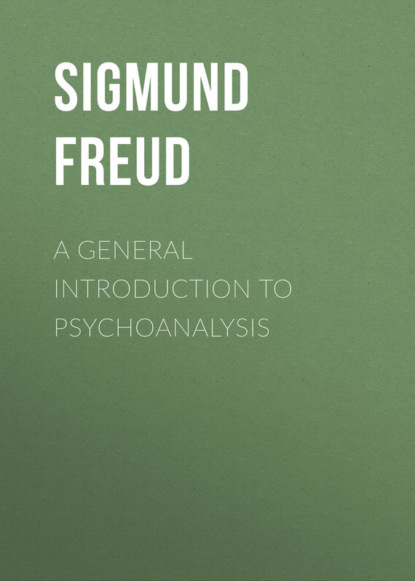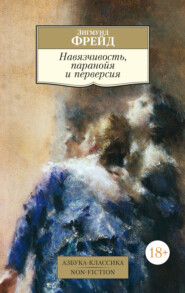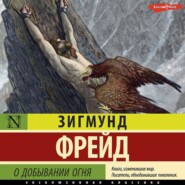По всем вопросам обращайтесь на: info@litportal.ru
(©) 2003-2024.
✖
A General Introduction to Psychoanalysis
Настройки чтения
Размер шрифта
Высота строк
Поля
The tearing off of a branch as the symbolic representation of onanism is not alone in keeping with the vulgar representation of the fact of onanism, but has far-reaching mythological parallels. Especially noteworthy, however, is the representation of onanism, or rather the punishment therefor, castration, by the falling out or pulling out of teeth, because there is a parallel in folk-lore which is probably known to the fewest dreamers. It does not seem at all questionable to me that the practice of circumcision common among so many peoples is an equivalent and a substitute for castration. And now we are informed that in Australia certain primitive tribes practice circumcision as a rite of puberty (the ceremony in honor of the boy's coming of age), while others, living quite near, have substituted for this act the striking out of a tooth.
I end my exposition with these examples. They are only examples. We know more about these matters, and you may well imagine how much richer and how much more interesting such a collection would appear if made, not by amateurs like ourselves, but by real experts in mythology, anthropology, philology and folk-lore. We are compelled to draw a few conclusions which cannot be exhaustive, but which give us much food for thought.
In the first place, we are faced by the fact that the dreamer has at his disposal a symbolic means of expression of which he is unconscious while awake, and does not recognize when he sees. That is as remarkable as if you should make the discovery that your chambermaid understands Sanskrit, although you know she was born in a Bohemian village and never learned the language. It is not easy to harmonize this fact with our psychological views. We can only say that the dreamer's knowledge of symbolism is unconscious, that it is a part of his unconscious mental life. We make no progress with this assumption. Until now it was only necessary to admit of unconscious impulses, those about which one knew nothing, either for a period of time or at all times. But now we deal with something more; indeed, with unknown knowledge, with thought relationships, comparisons between unlike objects which lead to this, that one constant may be substituted for another. These comparisons are not made anew each time, but they lie ready, they are complete for all time. That is to be concluded from the fact of their agreement in different persons, agreement despite differences in language.
But whence comes the knowledge of these symbol-relationships? The usages of language cover only a small part of them. The dreamer is for the most part unacquainted with the numerous parallels from other sources; we ourselves must first laboriously gather them together.
Secondly, these symbolic representations are peculiar neither to the dreamer nor to the dream work by means of which they become expressed. We have learned that mythology and fairy-tales make use of the same symbolism, as well as do the people in their sayings and songs, the ordinary language of every day, and poetic phantasy. The field of symbolism is an extraordinarily large one, and dream symbolism is but a small part thereof. It is not even expedient to approach the whole problem from the dream side. Many of the symbols that are used in other places do not occur in the dream at all, or at best only very seldom. Many of the dream symbols are to be found in other fields only very rarely, as you have seen. One gets the impression that he is here confronted with an ancient but no longer existent method of expression, of which various phases, however, continue in different fields, one here, one there, a third, perhaps in a slightly altered form, in several fields. I am reminded of the phantasy of an interesting mental defective, who had imagined a fundamental language, of which all these symbolic representations were the remains.
Thirdly, you must have noticed that symbolism in these other fields is by no means sex symbolism solely, while in the dream the symbols are used almost entirely to express sexual objects and processes. Nor is this easily explained. Is it possible that symbols originally sexual in their meaning later came to have other uses, and that this was the reason perhaps for the weakening of the symbolic representation to one of another nature? These questions are admittedly unanswerable if one has dealt only with dream-symbolism. One can only adhere to the supposition that there is an especially intimate connection between true symbols and things sexual.
An important indication of this has been given us recently. A philologist, H. Sperber (Upsala) who works independently of psychoanalysis, advanced the theory that sexual needs have played the largest part in the origin and development of languages. The first sounds served as means of communication, and called the sexual partner; the further development of the roots of speech accompanied the performance of the primitive man's work. This work was communal and progressed to the accompaniment of rhythmically repeated word sounds. In that way a sexual interest was transferred to the work. The primitive man made work acceptable at the same time that he used it as an equivalent and substitute for sex-activity. The word thus called forth by the common labor had two meanings, designating the sex-act as well as the equivalent labor-activity. In time the word became disassociated from its sexual significance and became fixed on this work. Generations later the same thing happened to a new word that once had sexual significance and came to be used for a new type of work. In this manner a number of word-roots were formed, all of sexual origin, and all of which had lost their sexual significance. If the description sketched here approximates the truth, it opens up the possibility for an understanding of the dream symbolism. We can understand how it is that in the dream, which preserves something of these most ancient conditions, there are so extraordinarily many symbols for the sexual, and why, in general, weapons and implements always stand for the male, materials and things manufactured, for the female. Symbolic relationships would be the remnants of the old word-identity; things which once were called by the same names as the genitals can now appear in the dream as symbols for them.
From our parallels to dream symbolization you may also learn to appreciate what is the character of psychoanalysis which makes it a subject of general interest, which is true of neither psychology nor psychiatry. Psychoanalytic work connects with so many other scientific subjects, the investigation of which promises the most pertinent discoveries, with mythology, with folk-lore, with racial psychology and with religion. You will understand how a journal can have grown on psychoanalytic soil, the sole purpose of which is the furtherance of these relationships. This is the Imago founded in 1912 and edited by Hanns Sachs and Otto Rank. In all of these relations, psychoanalysis is first and foremost the giving, less often the receiving, part. Indeed it derives benefit from the fact that its unusual teachings are substantiated by their recurrence in other fields, but on the whole it is psychoanalysis that provides the technical procedure and the point of view, the use of which will prove fruitful in those other fields. The psychic life of the human individual provides us, upon psychoanalytic investigation, with explanations with which we are able to solve many riddles in the life of humanity, or at least show these riddles in their proper light.
Furthermore, I have not even told you under what conditions we are able to get the deepest insight into that suppositious "fundamental language," or from which field we gain the most information. So long as you do not know this you cannot appreciate the entire significance of the subject. This field is the neurotic, its materials, the symptoms and other expressions of the nervous patient, for the explanation and treatment of which psychoanalysis was devised.
My fourth point of view returns to our premise and connects up with our prescribed course. We said, even if there were no such thing as dream censorship, the dream would still be hard to understand, for we would then be confronted with the task of translating the symbol-language of the dream into the thought of our waking hours. Symbolism is a second and independent item of dream distortion, in addition to dream censorship. It is not a far cry to suppose that it is convenient for the dream censorship to make use of symbolism since both lead to the same end, to making the dream strange and incomprehensible.
Whether or not in the further study of the dream we shall hit upon a new item that influences dream distortion, remains to be seen. I should not like to leave the subject of dream symbolism without once more touching upon the curious fact that it arouses such strong opposition in the case of educated persons, in spite of the fact that symbolism in myth, religion, art and speech is undoubtedly so prevalent. Is not this again because of its relationship to sexuality?
ELEVENTH LECTURE
THE DREAM
The Dream-Work
IF you have mastered dream censorship and symbolic representation, you are, to be sure, not yet adept in dream distortion, but you are nevertheless in a position to understand most dreams. For this you employ two mutually supplementary methods, call up the associations of the dreamer until you have penetrated from the substitute to the actual, and from your own knowledge supply the meaning for the symbol. Later we shall discuss certain uncertainties which show themselves in this process.
We are now in a position to resume work which we attempted, with very insufficient means at an earlier stage, when we studied the relation between the manifest dream elements and their latent actualities, and in so doing established four such main relationships: that of a part of the whole, that of approach or allusion, the symbolic relationship and plastic word representation. We shall now attempt the same on a larger scale, by comparing the manifest dream content as a whole, with the latent dream which we found by interpretation.
I hope you will never again confuse these two. If you have achieved this, you have probably accomplished more in the understanding of the dream than the majority of the readers of my Interpretation of Dreams. Let me remind you once more that this process, which changes the latent into the manifest dream, is called dream-work. Work which proceeds in the opposite direction, from the manifest dream to the latent, is our work of interpretation. The work of interpretation attempts to undo the dream-work. Infantile dreams that are recognized as evident wish fulfillments nevertheless have undergone some dream-work, namely, the transformation of the wish into reality, and generally, too, of thoughts into visual pictures. Here we need no interpretation, but only a retracing of these transformations. Whatever dream-work has been added to other dreams, we call dream distortion, and this can be annulled by our work of interpretation.
The comparison of many dream interpretations has rendered it possible for me to give you a coherent representation of what the dream-work does with the material of the latent dream. I beg of you, however, not to expect to understand too much of this. It is a piece of description that should be listened to with calm attention.
The first process of the dream-work is condensation. By this we understand that the manifest dream has a smaller content than the latent one, that is, it is a sort of abbreviated translation of the latter. Condensation may occasionally be absent, but as a rule it is present, often to a very high degree. The opposite is never true, that is, it never occurs that the manifest dream is more extensive in scope and content than the latent. Condensation occurs in the following ways: 1. Certain latent elements are entirely omitted; 2. only a fragment of the many complexes of the latent dream is carried over into the manifest dream; 3. latent elements that have something in common are collected for the manifest dream and are fused into a whole.
If you wish, you may reserve the term "condensation" for this last process alone. Its effects are particularly easy to demonstrate. From your own dreams you will doubtless recall the fusion of several persons into one. Such a compound person probably looks like A., is dressed like B., does something that one remembers of C., but in spite of this one is conscious that he is really D. By means of this compound formation something common to all four people is especially emphasized. One can make a compound formation of events and of places in the same way as of people, provided always that the single events and localities have something in common which the latent dream emphasizes. It is a sort of new and fleeting concept of formation, with the common element as its kernel. This jumble of details that has been fused together regularly results in a vague indistinct picture, as though you had taken several pictures on the same film.
The shaping of such compound formations must be of great importance to the dream-work, for we can prove, (by the choice of a verbal expression for a thought, for instance) that the common elements mentioned above are purposely manufactured where they originally do not exist. We have already become acquainted with such condensation and compound formations; they played an important part in the origin of certain cases of slips of the tongue. You recall the young man who wished to inscort a woman. Furthermore, there are jokes whose technique may be traced to such a condensation. But entirely aside from this, one may maintain that this appearance of something quite unknown in the dream finds its counterpart in many of the creations of our imagination which fuse together component parts that do not belong together in experience, as for example the centaurs, and the fabulous animals of old mythology or of Boecklin's pictures. For creative imagination can invent nothing new whatsoever, it can only put together certain details normally alien to one another. The peculiar thing, however, about the procedure of the dream-work is the following: The material at the disposal of the dream-work consists of thoughts, thoughts which may be offensive and unacceptable, but which are nevertheless correctly formed and expressed. These thoughts are transformed into something else by the dream-work, and it is remarkable and incomprehensible that this translation, this rendering, as it were, into another script or language, employs the methods of condensation and combination. For a translation usually strives to respect the discriminations expressed in the text, and to differentiate similar things. The dream-work, on the contrary, tries to fuse two different thoughts by looking, just as the joke does, for an ambiguous word which shall act as a connecting link between the two thoughts. One need not attempt to understand this feature of the case at once, but it may become significant for the conception of the dream-work.
Although condensation renders the dream opaque, one does not get the impression that it is an effect of dream censorship. One prefers to trace it back to mechanical or economic conditions; but censorship undoubtedly has a share in the process.
The results of condensation may be quite extraordinary. With its help, it becomes possible at times to collect quite unrelated latent thought processes into one manifest dream, so that one can arrive at an apparently adequate interpretation, and at the same time conceive a possible further interpretation.
The consequence of condensation for the relation between latent and manifest dreams is the fact that no simple relations can exist between the elements of the one and the other. A manifest element corresponds simultaneously to several latent ones, and vice versa, a latent element may partake of several manifest ones, an interlacing, as it were. In the interpretation of the dream it also becomes evident that the associations to a single element do not necessarily follow one another in orderly sequence. Often we must wait until the entire dream is interpreted.
Dream-work therefore accomplishes a very unusual sort of transcription of dream thoughts, not a translation word for word, or sign for sign, not a selection according to a set rule, as if all the consonants of a word were given and the vowels omitted; nor is it what we might call substitution, namely, the choice of one element to take the place of several others. It is something very different and much more complicated.
The second process of the dream-work is displacement. Fortunately we are already prepared for this, since we know that it is entirely the work of dream censorship. The two evidences of this are firstly, that a latent element is not replaced by one of its constituent parts but by something further removed from it, that is, by a sort of allusion; secondly, that the psychic accent is transferred from an important element to another that is unimportant, so that the dream centers elsewhere and seems strange.
Substitution by allusion is known to our conscious thinking also, but with a difference. In conscious thinking the allusion must be easily intelligible, and the substitute must bear a relation to the actual content. Jokes, too, often make use of allusion; they let the condition of content associations slide and replace it by unusual external associations, such as resemblances in sound, ambiguity of words, etc. They retain, however, the condition of intelligibility; the joke would lose all its effect if the allusion could not be traced back to the actual without any effort whatsoever. The allusion of displacement has freed itself of both these limitations. Its connection with the element which it replaces is most external and remote, is unintelligible for this reason, and if it is retraced, its interpretation gives the impression of an unsuccessful joke or of a forced, far-fetched explanation. For the dream censor has only then accomplished its purpose, when it has made the path of return from the allusion to the original undiscoverable.
The displacement of emphasis is unheard of as a means of expressing thoughts. In conscious thinking we occasionally admit it to gain a comic effect. I can probably give you an idea of the confusion which this produces by reminding you of the story of the blacksmith who had committed a capital crime. The court decided that the penalty for the crime must be paid, but since he was the only blacksmith in the village and therefore indispensable, while there were three tailors, one of the latter was hung in his stead.
The third process of the dream-work is the most interesting from a psychological point of view. It consists of the translation of thoughts into visual images. Let us bear in mind that by no means all dream thoughts undergo this translation; many of them retain their form and appear in the manifest dream also as thought or consciousness; moreover, visual images are not the only form into which thoughts are translated. They are, however, the foundation of the dream fabric; this part of the dream work is, as we already know, the second most constant, and for single dream elements we have already learned to know "plastic word representation."
It is evident that this process is not simple. In order to get an idea of its difficulties you must pretend that you have undertaken the task of replacing a political editorial in a newspaper by a series of illustrations, that you have suffered an atavistic return from the use of the alphabet to ideographic writing. Whatever persons or concrete events occur in this article you will be able to replace easily by pictures, perhaps to your advantage, but you will meet with difficulties in the representation of all abstract words and all parts of speech denoting thought relationships, such as particles, conjunctions, etc. With the abstract words you could use all sorts of artifices. You will, for instance, try to change the text of the article into different words which may sound unusual, but whose components will be more concrete and more adapted to representation. You will then recall that most abstract words were concrete before their meaning paled, and will therefore go back to the original concrete significance of these words as often as possible, and so you will be glad to learn that you can represent the "possession" of an object by the actual physical straddling of it.[32 - "besitzen," to straddle.] The dream work does the same thing. Under such circumstances you can hardly demand accuracy of representation. You will also have to allow the dream-work to replace an element that is as hard to depict as for instance, broken faith, by another kind of rupture, a broken leg.[33 - While revising these pages I chanced upon a newspaper article that I quote here as an unexpected supplement to the above lines.THE PUNISHMENT OF GODA BROKEN ARM FOR BROKEN FAITHMrs. Anna M. the wife of a soldier in the reserve accused Mrs. Clementine C. of being untrue to her husband. The accusation reads that Mrs. C. had carried on an illicit relationship with Karl M. while her own husband was on the battlefield, from which he even sent her 70 Kronen a month. Mrs. C. had received quite a lot of money from the husband of the plaintiff, while she and her children had to live in hunger and in misery. Friends of her husband had told her that Mrs. C. had visited inns with M. and had caroused there until late at night. The accused had even asked the husband of the plaintiff before several infantrymen whether he would not soon get a divorce from his "old woman" and live with her. Mrs. C.'s housekeeper had also repeatedly seen the husband of the plaintiff in her (Mrs. C.'s) apartment, in complete negligée.Yesterday Mrs. C. denied before a judge in Leopoldstadt that she even knew M; there could be no question of intimate relation between them.The witness, Albertine M., however, testified that Mrs. C. had kissed the husband of the plaintiff and that she had surprised them at it.When M. was called as a witness in an earlier proceeding he had denied any intimate relation to the accused. Yesterday the judge received a letter in which the witness retracts the statement he made in the first proceeding and admits that he had carried on a love affair with Mrs. C., until last June. He says that he only denied this relationship in the former proceeding for the sake of the accused because before the proceeding she had come to him and begged on her knees that he should save her and not confess. "To-day," wrote the witness, "I felt impelled to make a full confession to the court, since I have broken my left arm and this appears to me as the punishment of God for my transgression."The judge maintained the penal offense had already become null and void, whereupon the plaintiff withdrew her accusation and the liberation of the accused followed.] In this way you will be able to smooth away to some extent the crudity of imagery when the latter is endeavoring to replace word expression.
In the representation of parts of speech that denote thought relations, such as because, therefore, but, etc., you have no such aids; these constituent parts of the text will therefore be lost in your translation into images. In the same way, the dream-work resolves the content of the dream thought into its raw material of objects and activities. You may be satisfied if the possibility is vouchsafed you to suggest certain relations, not representable in themselves, in a more detailed elaboration of the image. In quite the same way the dream-work succeeds in expressing much of the content of the latent dream thought in the formal peculiarities of the manifest dream, in its clearness or vagueness, in its division into several parts, etc. The number of fragmentary dreams into which the dream is divided corresponds as a rule to the number of main themes, of thought sequences in the latent dream; a short preliminary dream often stands as an introduction or a motivation to the complementary dream which follows; a subordinate clause in dream thought is represented in the manifest dream as an interpolated change of scene, etc. The form of the dream is itself, therefore, by no means without significance and challenges interpretation. Different dreams of the same night often have the same meaning, and testify to an increasing effort to control a stimulus of growing urgency. In a single dream a particularly troublesome element may be represented by "duplicates," that is, by numerous symbols.
By continually comparing dream thought with the manifest dream that replaces it, we learn all sorts of things for which we were not prepared, as for instance, the fact that even the nonsense and absurdity of the dream have meaning. Yes, on this point the opposition between the medical and psychoanalytic conception of the dream reaches a climax not previously achieved. According to the former, the dream is senseless because the dreaming psychic activity has lost all power of critical judgment; according to our theory, on the other hand, the dream becomes senseless, whenever a critical judgment, contained in the dream thought, wishes to express the opinion: "It is nonsense." The dream which you all know, about the visit to the theatre (three tickets 1 Fl. 50 Kr.) is a good example of this. The opinion expressed here is: "It was nonsense to marry so early."
In the same way, we discover in interpretation what is the significance of the doubts and uncertainties so often expressed by the dreamer as to whether a certain element really occurred in the dream; whether it was this or something else. As a rule these doubts and uncertainties correspond to nothing in the latent dream thought; they are occasioned throughout by the working of the dream censor and are equivalent to an unsuccessful attempt at suppression.
One of the most surprising discoveries is the manner in which the dream-work deals with those things which are opposed to one another in the latent dream. We already know that agreements in the latent material are expressed in the manifest dream by condensations. Now oppositions are treated in exactly the same way as agreements and are, with special preference, expressed by the same manifest element. An element in a manifest dream, capable of having an opposite, may therefore represent itself as well as its opposite, or may do both simultaneously; only the context can determine which translation is to be chosen. It must follow from this that the particle "no" cannot be represented in the dream, at least not unambiguously.
The development of languages furnishes us with a welcome analogy for this surprising behavior on the part of the dream work. Many scholars who do research work in languages have maintained that in the oldest languages opposites – such as strong, weak; light, dark; big, little – were expressed by the same root word. (The Contradictory Sense of Primitive Words.) In old Egyptian, ken originally meant both strong and weak. In conversation, misunderstanding in the use of such ambiguous words was avoided by the tone of voice and by accompanying gestures, in writing by the addition of so-called determinatives, that is, by a picture that was itself not meant to be expressed. Accordingly, if ken meant strong, the picture of an erect little man was placed after the alphabetical signs, if ken, weak, was meant, the picture of a cowering man followed. Only later, by slight modifications of the original word, were two designations developed for the opposites which it denoted. In this way, from ken meaning both strong and weak, there was derived a ken, strong, and a ken, weak. It is said that not only the most primitive languages in their last developmental stage, but also the more recent ones, even the living tongues of to-day have retained abundant remains of this primitive opposite meaning. Let me give you a few illustrations of this taken from C. Abel (1884).
In Latin there are still such words of double meaning:
altus– high, deep, and sacer, sacred, accursed.
As examples of modifications of the same root, I cite:
clamare– to scream, clam– quiet, still, secret;
siccus– dry, succus– juice.
And from the German:
Stimme– voice, stumm– dumb.
The comparison of related tongues yields a wealth of examples:
English: lock; German: Loch– hole, Lücke– gap.
English: cleave; German: kleben– to stick, to adhere.
The English without, is to-day used to mean "not with"; that "with" had the connotation of deprivation as well as that of apportioning, is apparent from the compounds: withdraw, withhold. The German wieder, again, closely resembles this.
Another peculiarity of dream-work finds it prototype in the development of language. It occurred in ancient Egyptian as well as in other later languages that the sequence of sounds of the words was transposed to denote the same fundamental idea. The following are examples from English and German:
Topf—pot; boat—tub; hurry—Ruhe (rest, quiet).
Balken (beam) —Kloben (mallet) —club.
From the Latin and the German:
I end my exposition with these examples. They are only examples. We know more about these matters, and you may well imagine how much richer and how much more interesting such a collection would appear if made, not by amateurs like ourselves, but by real experts in mythology, anthropology, philology and folk-lore. We are compelled to draw a few conclusions which cannot be exhaustive, but which give us much food for thought.
In the first place, we are faced by the fact that the dreamer has at his disposal a symbolic means of expression of which he is unconscious while awake, and does not recognize when he sees. That is as remarkable as if you should make the discovery that your chambermaid understands Sanskrit, although you know she was born in a Bohemian village and never learned the language. It is not easy to harmonize this fact with our psychological views. We can only say that the dreamer's knowledge of symbolism is unconscious, that it is a part of his unconscious mental life. We make no progress with this assumption. Until now it was only necessary to admit of unconscious impulses, those about which one knew nothing, either for a period of time or at all times. But now we deal with something more; indeed, with unknown knowledge, with thought relationships, comparisons between unlike objects which lead to this, that one constant may be substituted for another. These comparisons are not made anew each time, but they lie ready, they are complete for all time. That is to be concluded from the fact of their agreement in different persons, agreement despite differences in language.
But whence comes the knowledge of these symbol-relationships? The usages of language cover only a small part of them. The dreamer is for the most part unacquainted with the numerous parallels from other sources; we ourselves must first laboriously gather them together.
Secondly, these symbolic representations are peculiar neither to the dreamer nor to the dream work by means of which they become expressed. We have learned that mythology and fairy-tales make use of the same symbolism, as well as do the people in their sayings and songs, the ordinary language of every day, and poetic phantasy. The field of symbolism is an extraordinarily large one, and dream symbolism is but a small part thereof. It is not even expedient to approach the whole problem from the dream side. Many of the symbols that are used in other places do not occur in the dream at all, or at best only very seldom. Many of the dream symbols are to be found in other fields only very rarely, as you have seen. One gets the impression that he is here confronted with an ancient but no longer existent method of expression, of which various phases, however, continue in different fields, one here, one there, a third, perhaps in a slightly altered form, in several fields. I am reminded of the phantasy of an interesting mental defective, who had imagined a fundamental language, of which all these symbolic representations were the remains.
Thirdly, you must have noticed that symbolism in these other fields is by no means sex symbolism solely, while in the dream the symbols are used almost entirely to express sexual objects and processes. Nor is this easily explained. Is it possible that symbols originally sexual in their meaning later came to have other uses, and that this was the reason perhaps for the weakening of the symbolic representation to one of another nature? These questions are admittedly unanswerable if one has dealt only with dream-symbolism. One can only adhere to the supposition that there is an especially intimate connection between true symbols and things sexual.
An important indication of this has been given us recently. A philologist, H. Sperber (Upsala) who works independently of psychoanalysis, advanced the theory that sexual needs have played the largest part in the origin and development of languages. The first sounds served as means of communication, and called the sexual partner; the further development of the roots of speech accompanied the performance of the primitive man's work. This work was communal and progressed to the accompaniment of rhythmically repeated word sounds. In that way a sexual interest was transferred to the work. The primitive man made work acceptable at the same time that he used it as an equivalent and substitute for sex-activity. The word thus called forth by the common labor had two meanings, designating the sex-act as well as the equivalent labor-activity. In time the word became disassociated from its sexual significance and became fixed on this work. Generations later the same thing happened to a new word that once had sexual significance and came to be used for a new type of work. In this manner a number of word-roots were formed, all of sexual origin, and all of which had lost their sexual significance. If the description sketched here approximates the truth, it opens up the possibility for an understanding of the dream symbolism. We can understand how it is that in the dream, which preserves something of these most ancient conditions, there are so extraordinarily many symbols for the sexual, and why, in general, weapons and implements always stand for the male, materials and things manufactured, for the female. Symbolic relationships would be the remnants of the old word-identity; things which once were called by the same names as the genitals can now appear in the dream as symbols for them.
From our parallels to dream symbolization you may also learn to appreciate what is the character of psychoanalysis which makes it a subject of general interest, which is true of neither psychology nor psychiatry. Psychoanalytic work connects with so many other scientific subjects, the investigation of which promises the most pertinent discoveries, with mythology, with folk-lore, with racial psychology and with religion. You will understand how a journal can have grown on psychoanalytic soil, the sole purpose of which is the furtherance of these relationships. This is the Imago founded in 1912 and edited by Hanns Sachs and Otto Rank. In all of these relations, psychoanalysis is first and foremost the giving, less often the receiving, part. Indeed it derives benefit from the fact that its unusual teachings are substantiated by their recurrence in other fields, but on the whole it is psychoanalysis that provides the technical procedure and the point of view, the use of which will prove fruitful in those other fields. The psychic life of the human individual provides us, upon psychoanalytic investigation, with explanations with which we are able to solve many riddles in the life of humanity, or at least show these riddles in their proper light.
Furthermore, I have not even told you under what conditions we are able to get the deepest insight into that suppositious "fundamental language," or from which field we gain the most information. So long as you do not know this you cannot appreciate the entire significance of the subject. This field is the neurotic, its materials, the symptoms and other expressions of the nervous patient, for the explanation and treatment of which psychoanalysis was devised.
My fourth point of view returns to our premise and connects up with our prescribed course. We said, even if there were no such thing as dream censorship, the dream would still be hard to understand, for we would then be confronted with the task of translating the symbol-language of the dream into the thought of our waking hours. Symbolism is a second and independent item of dream distortion, in addition to dream censorship. It is not a far cry to suppose that it is convenient for the dream censorship to make use of symbolism since both lead to the same end, to making the dream strange and incomprehensible.
Whether or not in the further study of the dream we shall hit upon a new item that influences dream distortion, remains to be seen. I should not like to leave the subject of dream symbolism without once more touching upon the curious fact that it arouses such strong opposition in the case of educated persons, in spite of the fact that symbolism in myth, religion, art and speech is undoubtedly so prevalent. Is not this again because of its relationship to sexuality?
ELEVENTH LECTURE
THE DREAM
The Dream-Work
IF you have mastered dream censorship and symbolic representation, you are, to be sure, not yet adept in dream distortion, but you are nevertheless in a position to understand most dreams. For this you employ two mutually supplementary methods, call up the associations of the dreamer until you have penetrated from the substitute to the actual, and from your own knowledge supply the meaning for the symbol. Later we shall discuss certain uncertainties which show themselves in this process.
We are now in a position to resume work which we attempted, with very insufficient means at an earlier stage, when we studied the relation between the manifest dream elements and their latent actualities, and in so doing established four such main relationships: that of a part of the whole, that of approach or allusion, the symbolic relationship and plastic word representation. We shall now attempt the same on a larger scale, by comparing the manifest dream content as a whole, with the latent dream which we found by interpretation.
I hope you will never again confuse these two. If you have achieved this, you have probably accomplished more in the understanding of the dream than the majority of the readers of my Interpretation of Dreams. Let me remind you once more that this process, which changes the latent into the manifest dream, is called dream-work. Work which proceeds in the opposite direction, from the manifest dream to the latent, is our work of interpretation. The work of interpretation attempts to undo the dream-work. Infantile dreams that are recognized as evident wish fulfillments nevertheless have undergone some dream-work, namely, the transformation of the wish into reality, and generally, too, of thoughts into visual pictures. Here we need no interpretation, but only a retracing of these transformations. Whatever dream-work has been added to other dreams, we call dream distortion, and this can be annulled by our work of interpretation.
The comparison of many dream interpretations has rendered it possible for me to give you a coherent representation of what the dream-work does with the material of the latent dream. I beg of you, however, not to expect to understand too much of this. It is a piece of description that should be listened to with calm attention.
The first process of the dream-work is condensation. By this we understand that the manifest dream has a smaller content than the latent one, that is, it is a sort of abbreviated translation of the latter. Condensation may occasionally be absent, but as a rule it is present, often to a very high degree. The opposite is never true, that is, it never occurs that the manifest dream is more extensive in scope and content than the latent. Condensation occurs in the following ways: 1. Certain latent elements are entirely omitted; 2. only a fragment of the many complexes of the latent dream is carried over into the manifest dream; 3. latent elements that have something in common are collected for the manifest dream and are fused into a whole.
If you wish, you may reserve the term "condensation" for this last process alone. Its effects are particularly easy to demonstrate. From your own dreams you will doubtless recall the fusion of several persons into one. Such a compound person probably looks like A., is dressed like B., does something that one remembers of C., but in spite of this one is conscious that he is really D. By means of this compound formation something common to all four people is especially emphasized. One can make a compound formation of events and of places in the same way as of people, provided always that the single events and localities have something in common which the latent dream emphasizes. It is a sort of new and fleeting concept of formation, with the common element as its kernel. This jumble of details that has been fused together regularly results in a vague indistinct picture, as though you had taken several pictures on the same film.
The shaping of such compound formations must be of great importance to the dream-work, for we can prove, (by the choice of a verbal expression for a thought, for instance) that the common elements mentioned above are purposely manufactured where they originally do not exist. We have already become acquainted with such condensation and compound formations; they played an important part in the origin of certain cases of slips of the tongue. You recall the young man who wished to inscort a woman. Furthermore, there are jokes whose technique may be traced to such a condensation. But entirely aside from this, one may maintain that this appearance of something quite unknown in the dream finds its counterpart in many of the creations of our imagination which fuse together component parts that do not belong together in experience, as for example the centaurs, and the fabulous animals of old mythology or of Boecklin's pictures. For creative imagination can invent nothing new whatsoever, it can only put together certain details normally alien to one another. The peculiar thing, however, about the procedure of the dream-work is the following: The material at the disposal of the dream-work consists of thoughts, thoughts which may be offensive and unacceptable, but which are nevertheless correctly formed and expressed. These thoughts are transformed into something else by the dream-work, and it is remarkable and incomprehensible that this translation, this rendering, as it were, into another script or language, employs the methods of condensation and combination. For a translation usually strives to respect the discriminations expressed in the text, and to differentiate similar things. The dream-work, on the contrary, tries to fuse two different thoughts by looking, just as the joke does, for an ambiguous word which shall act as a connecting link between the two thoughts. One need not attempt to understand this feature of the case at once, but it may become significant for the conception of the dream-work.
Although condensation renders the dream opaque, one does not get the impression that it is an effect of dream censorship. One prefers to trace it back to mechanical or economic conditions; but censorship undoubtedly has a share in the process.
The results of condensation may be quite extraordinary. With its help, it becomes possible at times to collect quite unrelated latent thought processes into one manifest dream, so that one can arrive at an apparently adequate interpretation, and at the same time conceive a possible further interpretation.
The consequence of condensation for the relation between latent and manifest dreams is the fact that no simple relations can exist between the elements of the one and the other. A manifest element corresponds simultaneously to several latent ones, and vice versa, a latent element may partake of several manifest ones, an interlacing, as it were. In the interpretation of the dream it also becomes evident that the associations to a single element do not necessarily follow one another in orderly sequence. Often we must wait until the entire dream is interpreted.
Dream-work therefore accomplishes a very unusual sort of transcription of dream thoughts, not a translation word for word, or sign for sign, not a selection according to a set rule, as if all the consonants of a word were given and the vowels omitted; nor is it what we might call substitution, namely, the choice of one element to take the place of several others. It is something very different and much more complicated.
The second process of the dream-work is displacement. Fortunately we are already prepared for this, since we know that it is entirely the work of dream censorship. The two evidences of this are firstly, that a latent element is not replaced by one of its constituent parts but by something further removed from it, that is, by a sort of allusion; secondly, that the psychic accent is transferred from an important element to another that is unimportant, so that the dream centers elsewhere and seems strange.
Substitution by allusion is known to our conscious thinking also, but with a difference. In conscious thinking the allusion must be easily intelligible, and the substitute must bear a relation to the actual content. Jokes, too, often make use of allusion; they let the condition of content associations slide and replace it by unusual external associations, such as resemblances in sound, ambiguity of words, etc. They retain, however, the condition of intelligibility; the joke would lose all its effect if the allusion could not be traced back to the actual without any effort whatsoever. The allusion of displacement has freed itself of both these limitations. Its connection with the element which it replaces is most external and remote, is unintelligible for this reason, and if it is retraced, its interpretation gives the impression of an unsuccessful joke or of a forced, far-fetched explanation. For the dream censor has only then accomplished its purpose, when it has made the path of return from the allusion to the original undiscoverable.
The displacement of emphasis is unheard of as a means of expressing thoughts. In conscious thinking we occasionally admit it to gain a comic effect. I can probably give you an idea of the confusion which this produces by reminding you of the story of the blacksmith who had committed a capital crime. The court decided that the penalty for the crime must be paid, but since he was the only blacksmith in the village and therefore indispensable, while there were three tailors, one of the latter was hung in his stead.
The third process of the dream-work is the most interesting from a psychological point of view. It consists of the translation of thoughts into visual images. Let us bear in mind that by no means all dream thoughts undergo this translation; many of them retain their form and appear in the manifest dream also as thought or consciousness; moreover, visual images are not the only form into which thoughts are translated. They are, however, the foundation of the dream fabric; this part of the dream work is, as we already know, the second most constant, and for single dream elements we have already learned to know "plastic word representation."
It is evident that this process is not simple. In order to get an idea of its difficulties you must pretend that you have undertaken the task of replacing a political editorial in a newspaper by a series of illustrations, that you have suffered an atavistic return from the use of the alphabet to ideographic writing. Whatever persons or concrete events occur in this article you will be able to replace easily by pictures, perhaps to your advantage, but you will meet with difficulties in the representation of all abstract words and all parts of speech denoting thought relationships, such as particles, conjunctions, etc. With the abstract words you could use all sorts of artifices. You will, for instance, try to change the text of the article into different words which may sound unusual, but whose components will be more concrete and more adapted to representation. You will then recall that most abstract words were concrete before their meaning paled, and will therefore go back to the original concrete significance of these words as often as possible, and so you will be glad to learn that you can represent the "possession" of an object by the actual physical straddling of it.[32 - "besitzen," to straddle.] The dream work does the same thing. Under such circumstances you can hardly demand accuracy of representation. You will also have to allow the dream-work to replace an element that is as hard to depict as for instance, broken faith, by another kind of rupture, a broken leg.[33 - While revising these pages I chanced upon a newspaper article that I quote here as an unexpected supplement to the above lines.THE PUNISHMENT OF GODA BROKEN ARM FOR BROKEN FAITHMrs. Anna M. the wife of a soldier in the reserve accused Mrs. Clementine C. of being untrue to her husband. The accusation reads that Mrs. C. had carried on an illicit relationship with Karl M. while her own husband was on the battlefield, from which he even sent her 70 Kronen a month. Mrs. C. had received quite a lot of money from the husband of the plaintiff, while she and her children had to live in hunger and in misery. Friends of her husband had told her that Mrs. C. had visited inns with M. and had caroused there until late at night. The accused had even asked the husband of the plaintiff before several infantrymen whether he would not soon get a divorce from his "old woman" and live with her. Mrs. C.'s housekeeper had also repeatedly seen the husband of the plaintiff in her (Mrs. C.'s) apartment, in complete negligée.Yesterday Mrs. C. denied before a judge in Leopoldstadt that she even knew M; there could be no question of intimate relation between them.The witness, Albertine M., however, testified that Mrs. C. had kissed the husband of the plaintiff and that she had surprised them at it.When M. was called as a witness in an earlier proceeding he had denied any intimate relation to the accused. Yesterday the judge received a letter in which the witness retracts the statement he made in the first proceeding and admits that he had carried on a love affair with Mrs. C., until last June. He says that he only denied this relationship in the former proceeding for the sake of the accused because before the proceeding she had come to him and begged on her knees that he should save her and not confess. "To-day," wrote the witness, "I felt impelled to make a full confession to the court, since I have broken my left arm and this appears to me as the punishment of God for my transgression."The judge maintained the penal offense had already become null and void, whereupon the plaintiff withdrew her accusation and the liberation of the accused followed.] In this way you will be able to smooth away to some extent the crudity of imagery when the latter is endeavoring to replace word expression.
In the representation of parts of speech that denote thought relations, such as because, therefore, but, etc., you have no such aids; these constituent parts of the text will therefore be lost in your translation into images. In the same way, the dream-work resolves the content of the dream thought into its raw material of objects and activities. You may be satisfied if the possibility is vouchsafed you to suggest certain relations, not representable in themselves, in a more detailed elaboration of the image. In quite the same way the dream-work succeeds in expressing much of the content of the latent dream thought in the formal peculiarities of the manifest dream, in its clearness or vagueness, in its division into several parts, etc. The number of fragmentary dreams into which the dream is divided corresponds as a rule to the number of main themes, of thought sequences in the latent dream; a short preliminary dream often stands as an introduction or a motivation to the complementary dream which follows; a subordinate clause in dream thought is represented in the manifest dream as an interpolated change of scene, etc. The form of the dream is itself, therefore, by no means without significance and challenges interpretation. Different dreams of the same night often have the same meaning, and testify to an increasing effort to control a stimulus of growing urgency. In a single dream a particularly troublesome element may be represented by "duplicates," that is, by numerous symbols.
By continually comparing dream thought with the manifest dream that replaces it, we learn all sorts of things for which we were not prepared, as for instance, the fact that even the nonsense and absurdity of the dream have meaning. Yes, on this point the opposition between the medical and psychoanalytic conception of the dream reaches a climax not previously achieved. According to the former, the dream is senseless because the dreaming psychic activity has lost all power of critical judgment; according to our theory, on the other hand, the dream becomes senseless, whenever a critical judgment, contained in the dream thought, wishes to express the opinion: "It is nonsense." The dream which you all know, about the visit to the theatre (three tickets 1 Fl. 50 Kr.) is a good example of this. The opinion expressed here is: "It was nonsense to marry so early."
In the same way, we discover in interpretation what is the significance of the doubts and uncertainties so often expressed by the dreamer as to whether a certain element really occurred in the dream; whether it was this or something else. As a rule these doubts and uncertainties correspond to nothing in the latent dream thought; they are occasioned throughout by the working of the dream censor and are equivalent to an unsuccessful attempt at suppression.
One of the most surprising discoveries is the manner in which the dream-work deals with those things which are opposed to one another in the latent dream. We already know that agreements in the latent material are expressed in the manifest dream by condensations. Now oppositions are treated in exactly the same way as agreements and are, with special preference, expressed by the same manifest element. An element in a manifest dream, capable of having an opposite, may therefore represent itself as well as its opposite, or may do both simultaneously; only the context can determine which translation is to be chosen. It must follow from this that the particle "no" cannot be represented in the dream, at least not unambiguously.
The development of languages furnishes us with a welcome analogy for this surprising behavior on the part of the dream work. Many scholars who do research work in languages have maintained that in the oldest languages opposites – such as strong, weak; light, dark; big, little – were expressed by the same root word. (The Contradictory Sense of Primitive Words.) In old Egyptian, ken originally meant both strong and weak. In conversation, misunderstanding in the use of such ambiguous words was avoided by the tone of voice and by accompanying gestures, in writing by the addition of so-called determinatives, that is, by a picture that was itself not meant to be expressed. Accordingly, if ken meant strong, the picture of an erect little man was placed after the alphabetical signs, if ken, weak, was meant, the picture of a cowering man followed. Only later, by slight modifications of the original word, were two designations developed for the opposites which it denoted. In this way, from ken meaning both strong and weak, there was derived a ken, strong, and a ken, weak. It is said that not only the most primitive languages in their last developmental stage, but also the more recent ones, even the living tongues of to-day have retained abundant remains of this primitive opposite meaning. Let me give you a few illustrations of this taken from C. Abel (1884).
In Latin there are still such words of double meaning:
altus– high, deep, and sacer, sacred, accursed.
As examples of modifications of the same root, I cite:
clamare– to scream, clam– quiet, still, secret;
siccus– dry, succus– juice.
And from the German:
Stimme– voice, stumm– dumb.
The comparison of related tongues yields a wealth of examples:
English: lock; German: Loch– hole, Lücke– gap.
English: cleave; German: kleben– to stick, to adhere.
The English without, is to-day used to mean "not with"; that "with" had the connotation of deprivation as well as that of apportioning, is apparent from the compounds: withdraw, withhold. The German wieder, again, closely resembles this.
Another peculiarity of dream-work finds it prototype in the development of language. It occurred in ancient Egyptian as well as in other later languages that the sequence of sounds of the words was transposed to denote the same fundamental idea. The following are examples from English and German:
Topf—pot; boat—tub; hurry—Ruhe (rest, quiet).
Balken (beam) —Kloben (mallet) —club.
From the Latin and the German:

















